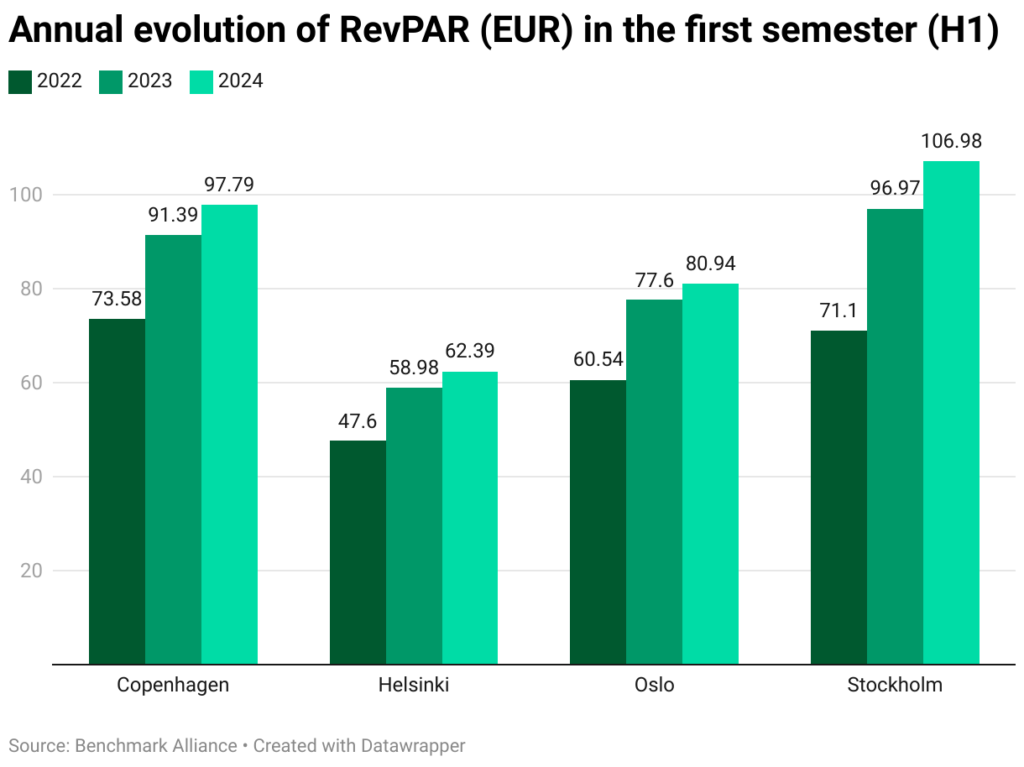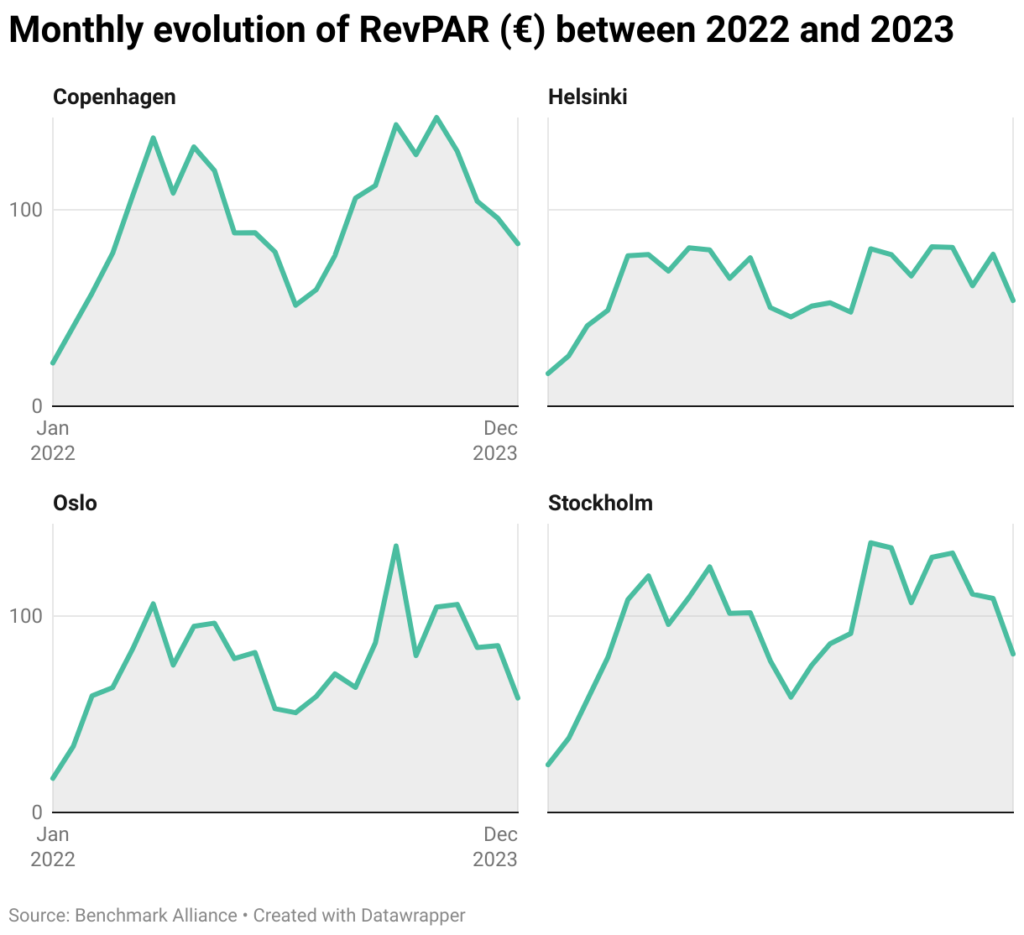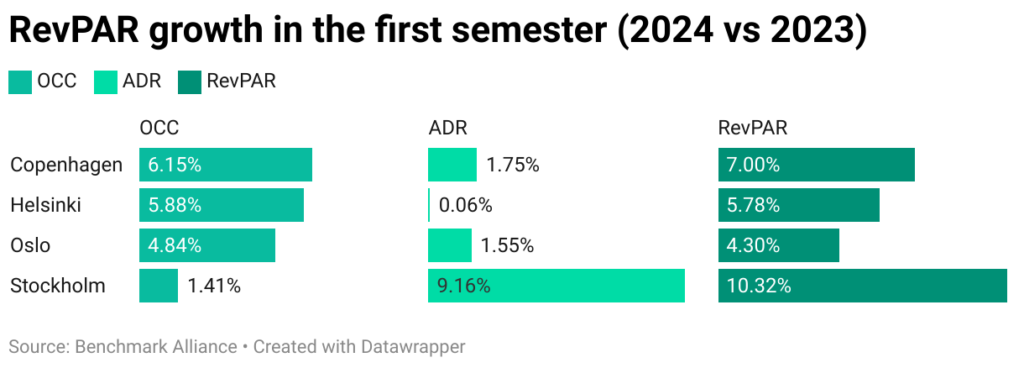
Research conducted by BEONx, revenue solution provider for hotels in Europe, reveals that, since late 2021, following the impact of COVID-19 on tourism, a shift in trends has driven remarkable growth for hotels, allowing the sector to recover quickly and reach pre-pandemic 2019 levels. This momentum has not stopped; factors such as inflation and the resurgence in demand have propelled hotels to record highs, surpassing industry expectations in both revenue and occupancy.
Stockholm, for instance, saw a 36.38% surge in revenue, climbing from 71.1€ in the first half of 2022 to 96.97€ per room in the same period of 2023. Oslo, Copenhagen, and Helsinki experienced similar growth rates, with increases of 28.1%, 24.2%, and 23.9% respectively. These increases were especially noticeable in the first quarter, as the market was still feeling the lingering effects of Covid-19. This significant revenue surge created some uncertainty, with concerns about a potential “rebound effect” due to these unexpectedly positive gains.
Hotel revenue growth moderates in 2024
While extreme growth levels have tapered off in early 2024, the outlook remains highly positive, with revenues still reaching historic highs. The extreme growth has transitioned into more sustainable and moderate increases in hotel revenues. In the first half of the year, annual growth rates in the Nordic capitals, which previously ranged from 24-30%, have now settled to more reasonable levels between 5 and 10%. These increases are more consistent with pre-pandemic growth rates, although they remain high compared to historical averages of 1 to 5% annually.
During this period, Stockholm recorded the highest revenue per room at 106.94€, followed by Copenhagen at 97.79€, Oslo at 80.94€, and Helsinki at 62.92€.

Occupancy vs Pricing
A key factor to achieve these annual gains is the variety of strategies hotels have implemented. In Oslo, Copenhagen, and Helsinki, revenue growth is primarily driven by a higher volume of tourists (between 5% and 6%), while the average revenue per room has remained relatively stable.
In contrast, in Stockholm, revenue growth has surged to a robust 10.32% due to a significant rise in prices (9.16%), even though hotel occupancy has only seen a modest increase of 1.41% during the same period in 2024. This could be because Stockholm, being the Nordic capital with the highest occupancy rate in 2023, reaching 75% of the total, needs to optimize prices to improve results given stock limitations.
These two strategies—occupancy and pricing—are commonly used by revenue managers and reflect broader global trends.

Forecasting the Future
While growth in the Nordic hotel market has moderated, the trend remains positive and promising. Having flexible strategies and leveraging advanced technologies will be crucial in sustaining this trend.
Diverse strategies in pricing and occupancy have proven effective in maintaining stability and achieving sustainable growth. Each hotel should adopt a personalized revenue management strategy that considers its market, customer segment, and competition.
Tomasz Leszczynski, Director of Sales in Northern Europe at BEONx and a revenue management expert, explains that “the possibility of a rebound effect exists, particularly in such a dynamic market. Hotels can mitigate this risk by employing data-driven revenue management strategies, adjusting prices and offerings according to market fluctuations, and diversifying their income sources”.

Increasing profitability requires a combination of operational efficiency, price optimization, and an enhanced guest experience. Investing in technology to automate processes and dynamically adjust rates will help maximize revenue, anticipate trends, adjust supply to demand, and ultimately improve performance in these ever-changing times. As Álvaro Ponte, VP of Data at BEONx, adds: “Leveraging artificial intelligence technology for real-time price adjustments can significantly enhance both occupancy and revenue.”
Moving forward, leveraging advanced technology and adapting to market dynamics will be crucial for hotels to capitalize on future opportunities. Although the path ahead may be uncertain, those equipped with flexible, data-driven strategies and cutting-edge technology will be well-positioned to thrive.
Data Source: BEONx and Benchmark Alliance


